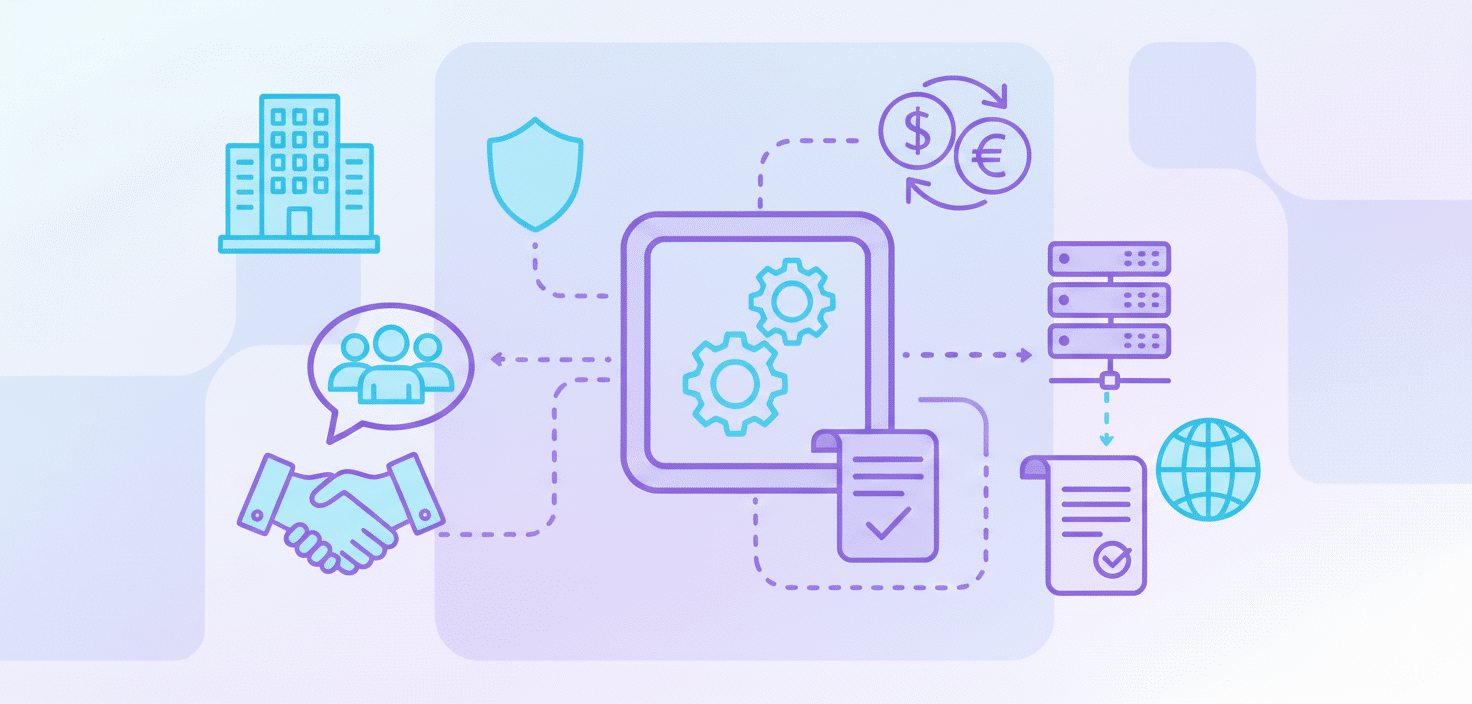SaaS 유형
B2B SaaS란 무엇인가요?

B2B SaaS란 무엇인가요?
B2B SaaS (기업 간 서비스형 소프트웨어)는 사용자가 구독 기반으로 애플리케이션에 액세스할 수 있도록 하는 소프트웨어 제공 모델입니다. B2B SaaS는 클라우드 기반이므로, 설치 없이 원격으로 시스템에 액세스할 수 있습니다.
B2B SaaS의 특징은 다음과 같습니다:
- 목적: 비즈니스 요구사항을 충족시키기 위해 만들어졌습니다.
- 액세스: B2B SaaS 솔루션은 언제든지 이용 가능하며 시스템 업데이트가 수시로 진행됩니다.
- 업계 데이터: 글로벌 SaaS 시장은 ~에 도달할 것으로 예상됩니다. 2,320억 달러 2024년에.
B2B SaaS 모델은 어떻게 작동하나요?
B2B SaaS는 구독 기반이며, 기업은 애플리케이션에 접근하기 위해 월별 또는 연간 요금을 지불해야 합니다.
- 고객(기업)을 위한 사항:
- 클라우드를 통해 소프트웨어에 접근합니다.
- 자동 업데이트 및 유지보수는 B2B SaaS 제공업체가 처리합니다.
- 제공업체(SaaS 기업)를 위한 사항:
- 인프라, 클라우드 스토리지, 데이터 및 기술 업데이트를 유지 관리합니다.
- 예측 가능한 수익 흐름을 구축합니다. (SaaS 구독 매출이 성장했습니다 437% 지난 10년 동안).
B2B SaaS와 온프레미스 솔루션의 장점은 무엇인가요?
B2B SaaS는 기존 온프레미스 소프트웨어와 비교하여 비용, 접근성, 확장성 및 유지 관리 측면에서 차이를 보이며 다른 접근 방식을 제시합니다.
|
기능 |
B2B SaaS (클라우드) |
온프레미스 (기존 방식) |
|
비용 구조 |
하드웨어 및 소프트웨어에 대한 상당한 초기 투자를 없애고 상당한 비용 절감 효과를 가져옵니다 (Binary Studio). 대부분의 공급업체는 유연한 구독 플랜을 제공합니다. |
라이선스 & 하드웨어에 대한 높은 초기 비용 (CapEx). |
|
확장성 |
우수한 확장성: 변화하는 요구사항에 맞춰 사용량과 기능을 쉽게 조정할 수 있습니다 (Dialpad). |
추가 하드웨어 구매 및 관리가 필요합니다. |
|
유지 관리 |
공급업체에서 전적으로 처리하므로, 회사의 IT 부서는 전략적인 이니셔티브에 집중할 수 있습니다. |
회사 내부 IT 팀에서 처리합니다. |
|
사용성 |
일반적으로 사용하기 더 쉽고 강력한 보고 도구를 갖추고 있습니다. |
매우 다양하며; 종종 전문적인 IT 전문 지식이 필요합니다. |
|
제어 |
환경에 대한 통제력이 적습니다 (공급업체가 인프라 및 업데이트를 관리합니다). |
하드웨어, 데이터 및 업데이트에 대한 완벽한 제어. |
|
의존성 |
~에 대한 의존 안정적인 인터넷 연결 매우 중요하며, 서비스 중단은 접근성에 영향을 미칩니다. |
외부 인터넷 없이 (내부 네트워크에서) 작동합니다. |
|
보안 위험 |
SaaS 제공업체의 보안 조치와 규정 준수 인증에 대한 신중한 평가가 필요합니다. |
보안 및 개인 정보 보호는 전적으로 기업에서 관리합니다. |
B2B SaaS는 어떤 문제를 해결해 주나요?
B2B SaaS 솔루션은 현재의 비즈니스 환경에서 다양한 고려 사항과 관련이 있습니다.
- 리소스 관리: 구독 비용 예측 가능성은 기업의 예상치 못한 지출 감소로 이어질 수 있습니다.
- 데이터 보안 & 백업: 정보가 클라우드 환경으로 이동함에 따라 데이터 보안 및 제어를 제공합니다.
- B2B SaaS 솔루션은 현대 비즈니스 환경에서 중요한 여러 고려 사항을 해결합니다..
- 운영 효율성: 향상된 커뮤니케이션 및 의사 결정 도구를 통해 긴 B2B 판매 주기를 단축합니다.
- 사용자 정의: B2B 고객의 다양하고 맞춤화된 요구 사항을 충족하는 옵션을 제공합니다.
- 규정 준수: 고객 신뢰 유지 및 규제 준수에 필수적인 보안 프로토콜을 구현합니다.
B2B SaaS 솔루션 선택 시 주요 고려사항은 무엇인가요?
장기적인 운영 적합성과 가치를 위해 B2B SaaS 솔루션을 선택할 때 다음 사항들을 고려하십시오:
- 즉각적인 비즈니스 가치: 솔루션은 핵심적인 문제를 해결해야 합니다.
- 지속적인 개선: 정기적인 업데이트를 수행하고 산업 지침을 따르는 B2B SaaS 솔루션을 선택하십시오.
- 확장성: 산업 변화에 적응하는 B2B SaaS 애플리케이션의 능력은 사용 비용에 영향을 미칠 수 있습니다.
- 데이터 보안: 공급업체는 강력한 데이터 보안 조치를 제공해야 합니다.
- 사용자 경험: UI/UX 디자인은 사용자에게 중요합니다.
B2B SaaS는 데이터 보안 및 규정 준수를 어떻게 처리하나요?
B2B SaaS 개발자는 다양한 법적 기준을 준수하고 특정 기술적 조치를 구현함으로써 데이터 보안 및 규정 준수에 대한 책임이 있습니다.
여기에는 다음이 포함됩니다.
B2B SaaS는 제 비즈니스 요구사항에 맞춰 발전할 수 있을까요?
네, B2B SaaS 솔루션은 일반적으로 발전하고 유연성을 제공하도록 설계되었습니다. 발전은 다음을 통해 이루어집니다.
- 클라우드 기반 솔루션 운영 기능(사용자 추가 또는 제거, 기능 조정)을 수정하고 지정된 요구 사항에 맞게 사용자 정의할 수 있는 옵션을 제공합니다.
- 통합: 기존 시스템 및 산업별 도구와의 호환성을 포함합니다.
- 미래 대비: AI와 같은 첨단 기술을 활용하는 공급업체를 찾으세요, 머신 러닝, 및 마이크로서비스.
- 옴니채널 기능: 다양한 비즈니스 채널에서 통합된 경험을 지원합니다.
B2B SaaS 가격 책정은 내 비즈니스에 맞춰 어떻게 확장되나요?
B2B SaaS 가격 책정은 사용자 요구사항에 맞춰 확장되도록 다양한 유형으로 구성됩니다. 가격 전략은 예산 또는 사용량 변경에 따라 수정될 수 있습니다.
- 단계별 가격 책정: 더 많은 기능 또는 사용량 수준에 액세스하기 위해 더 비싼 요금제로 업그레이드할 수 있습니다.
- 사용자당 가격: B2B SaaS 애플리케이션에 접근하는 사용자 수를 기반으로 투명하고 간단한 비용 예측을 제공합니다.
- 가치 기반 가격 책정은: 사용자 성과를 인지된 가치와 연결합니다.
결론
B2B SaaS는 기업에게 기존 온프레미스 소프트웨어의 대안을 제시하며, 유연성, 접근성 및 비용에 잠재적으로 영향을 미칠 수 있습니다. B2B SaaS 모델, 확장성과 같은 잠재적 이점, 그리고 선택을 위한 주요 고려 사항을 이해하는 것은 기업의 운영 효율성과 비용 구조에 영향을 미칠 수 있습니다.